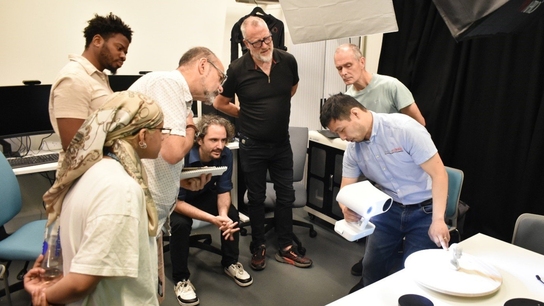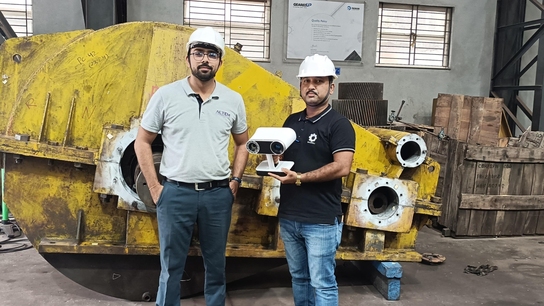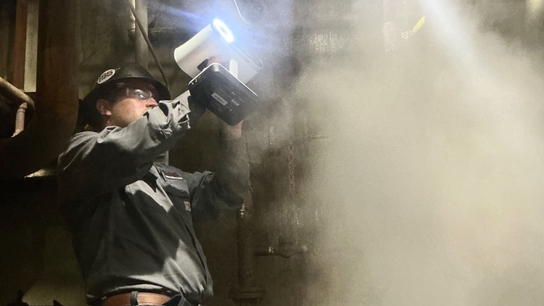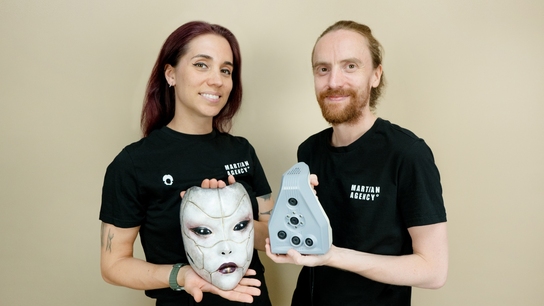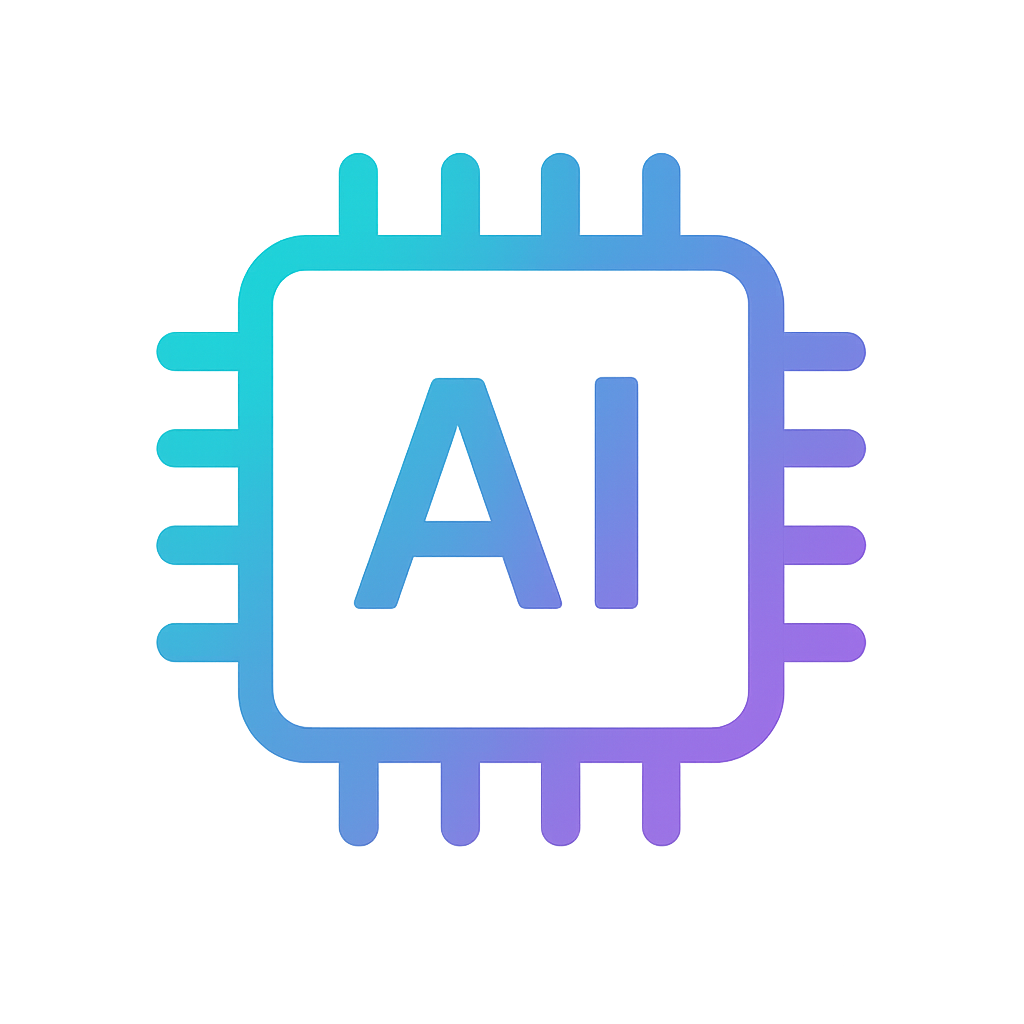Giving peace a digital chance: Artec Leo and Ray II capture The Gun Sculpture
Challenge: Canadian artists Sandra Bromley and Wallis Kendal needed a way to digitally preserve and share “The Gun Sculpture,” a highly detailed anti-violence artwork, standing 2.5 meters tall and weighing roughly five tons. Due to the sculpture’s enormous size, intricate structure, and reflective metal surfaces, conventional capture methods like photography or video failed to convey its full presence, scale, and emotional impact.
Solution: Artec Leo, Artec Ray II, Artec Studio
Result: A complete, high-resolution 3D model to enable digital and remote exhibitions, as well as enhance museum education and outreach.
Why Artec: A hybrid approach using two scanners made it possible to work around difficult scanning angles, flat metallic surfaces, dark materials, and logistical limitations. Combining Leo’s wireless operation and Ray II’s long-range capabilities allowed for the capture of both accurate data in tight exhibition spaces and the full size of the sculpture – all aligned and refined entirely in Artec Studio, with no need for any external software.
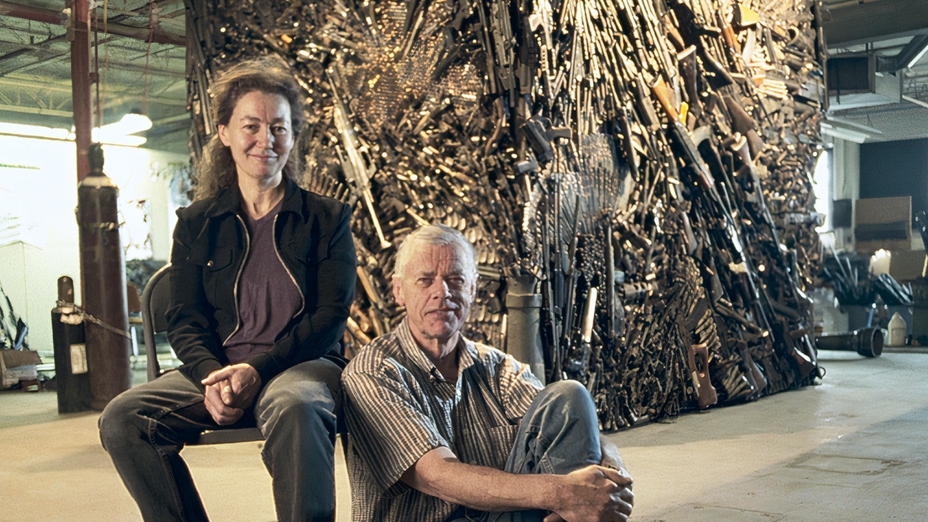
Artists Sandra Bromley and Wallis Kendall in the original Gun Sculpture studio. Image courtesy of the artists
A global statement for deconstructing violence
Challenging the culture of violence has never been easy. Throughout human history, peacemakers have not necessarily been welcome, whether socially, politically, or artistically. Guns are tied to deep-rooted ideas: power dynamics, battling for resources to survive, or simply the human urge to conquer and protect, impulses that often switch places. But what if it were the guns themselves that were used to creatively combat the concept of violence?
This is exactly what Canadian artists Sandra Bromley and Wallis Kendal had in mind. It took them five years to create The Gun Sculpture, a monumental anti-violence artwork that weighed five tons yet was designed for touring. The sculpture disassembles into 14 units for crating and shipping, and has since traveled to three continents, seen by over 1.75 million people.
Some quick facts and figures to imagine the scale: in total, over 8,000 weapons were donated by NGOs, military, police, governments, and student groups from all across the globe, including South Africa, Nicaragua, South Korea, and Spain. More than 7,000 of those were used in the sculpture, with the remaining 1,000 becoming a part of smaller works. The artists personally deactivated over 4,000 of the weapons.
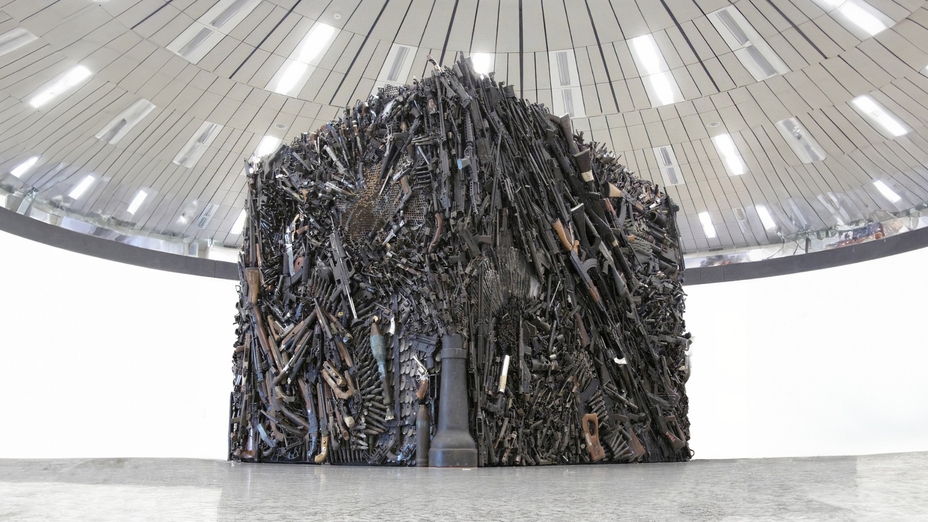
The Gun Sculpture exhibited in Vienna. Image courtesy of the creators
The full Art of Peacemaking installation includes three interactive elements: the sculpture itself, a victim remembrance wall, and a blackboard to collect and document visitor responses. Delivering a powerful message of peace, the project has invited viewers to confront the realities of violence for 25 years. However, after more than two decades of activism, museum education, and global touring, the artists decided it was time to permanently place their creation. They also recognized a growing need for an online presence in the current technological landscape. This raised a question – how to translate the scale and detail of the sculpture into a digital format that would enable viewers to explore the piece just as thoroughly?
Storytelling in 3D: looking for the tool
“One thing we’d always wanted to do, but never had the opportunity or the right technology for, was to create a 3D scan. So, before the sculpture left our city, we decided to capture high-resolution video, photography, and augment that with scanning,” explained Sandra Bromley. “We’ve always struggled to communicate the essence of this project through photos or even video. It’s a very interactive piece. People touch it, walk around it, walk inside the sculpture, and engage with the Victims’ Remembrance Wall. A 3D scan seemed like a powerful tool to fully capture that experience and provide access both through an online version and eventually a virtual exhibit.”
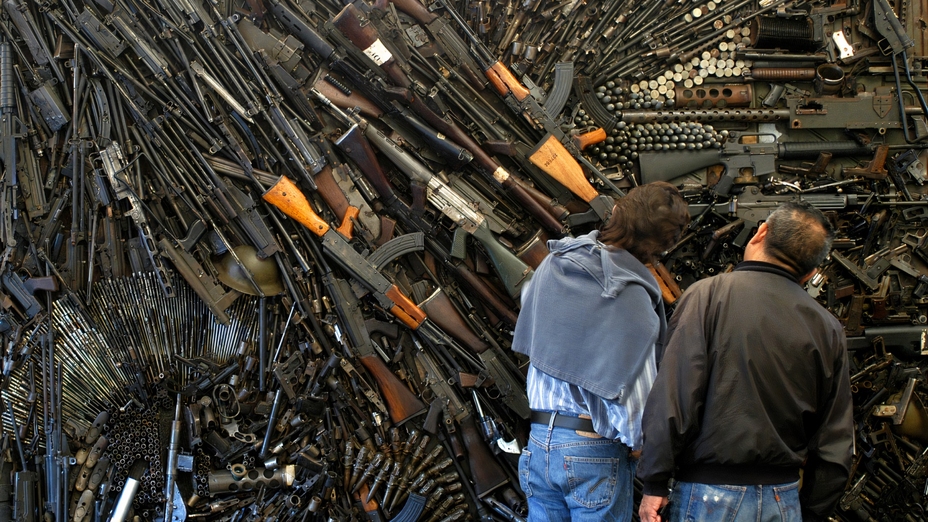
Considerable scanning challenge of 7,000 dark, metallic weapons. Image courtesy of the creators
Bromley began researching 3D scanning, found Artec 3D, and was quite impressed by the capabilities of the technology detailed on its website. Directed upon her inquiry to My Engineering Ltd, Artec 3D’s devoted Ambassador in Canada, the artist invited the team to explore the artwork and see if 3D technology could address her needs.
The power of two
The team from My Engineering arrived on location at an exhibition showcasing the piece. Experts in Artec 3D’s complete line-up of scanners, they were fully prepared to choose the best solution on the spot. While they had a general sense of the sculpture’s size and complexity from photos, the full scope wasn’t clear. Ultimately, they opted for Artec Leo, a handheld 3D scanner offering unlimited tetherless portability and real-time onboard processing.
This flagship device has earned a reputation as being ideal for capturing detailed features of heritage objects and interiors with high resolution and color fidelity. The tool was just right, and the team scanned the entire art piece with Leo – capturing each wall individually, including corners and transitions – so the data could be then blended together seamlessly, both inside and out.
“Each wall looked great on its own. We rendered and colorized them – and the color came out even better than we expected,” shared Mark Steblyk, 3D scanning product specialist at My Engineering. “The Leo performed really well, especially considering the flat metallic surfaces and dark materials, which are typically challenging.”
The team also found it really helpful to use Artec Ray II to scan the overall structure and provide a reference framework for alignment. A long-range LiDAR, Ray II is designed for high-precision capture of large structures, such as buildings or monuments, making it particularly valuable for preserving complex art sites at scale.
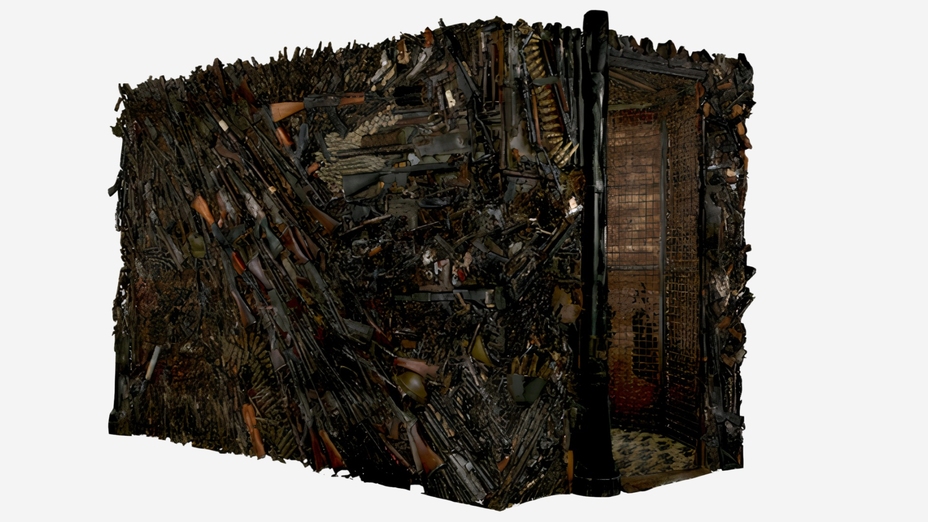
3D Model of The Gun Sculpture. Image courtesy of My Engineering
The Leo-Ray scanner tandem has already been a hit with heritage preservation professionals. Whether at an open-air ethnographic museum in Poland or uncovering hidden gravestones underneath a historical church in the Netherlands, the robust duo delivers every time: capturing massive scale without sacrificing the tiniest details. For My Engineering, this ambitious endeavor went beyond the scope of their typical projects in terms of size and complexity, so the resulting single, cohesive model also proved to be a valuable learning opportunity for the team.
From scan to model, end-to-end
After all the data from Leo and Ray II was perfectly aligned, it was up to the software to turn it into a high-res digital twin. Considering the sculpture’s height of 2.5 meters, the incredible abundance of detail, the narrow spaces between the gun barrels, and the substantial size of the scans, one might have expected this would be the job for more than one tool. However, the team managed using only Artec Studio – the standard workflow was sufficient for complete processing.
“Once I merged the data from the two scanners in Studio, the final model became complete,” said Steblyk. “We thought we might need to bring it into Blender or another software for refining, especially since we took a lot of reference photos. But in the end, Artec Studio handled everything, from start to finish, and we didn’t need to add external textures at all.”
Artec Studio is built to easily handle massive datasets, which ensures smooth performance even with extremely large and detailed models, such as The Gun Sculpture. When combining scans from Leo and Ray II, the software’s features like Global Registration, Rigid and Non-Rigid Alignment, and Smart Texture Mapping are all essential for achieving both high-precision alignment and seamless texture blending across datasets of varying resolution and scale.
Sandra Bromley documented the entire digitization process while the specialists from MyEngineering created a 3D replica of her artwork. “For a non-professional, it was a fascinating process,” observed the artist. “I’m really impressed with the processing because for art projects, especially for art projects this complex and this massive, most of the time you would have to use some additional tools. So I’m astonished to realize it was just Artec studio.”
Expand the access, extend the impact
For MyEngineering, who thrive on a good challenge, the outcome of this project became a way to broaden their professional horizons. The team is keen to put Artec’s latest scanners to the test, especially devices that are gaining popularity in fields ranging from inspection to art and education. “Since this project, we’ve started reaching out to different museums and doing a bit of an art-focused campaign, looking at how we can use our scanners, whether for services or on the sales side,” said Steblyk. “We’ve recently gotten an Artec Spider II, and we’re excited to start using it on very complex, small objects, where it’s really important to capture the geometry and color accurately.”
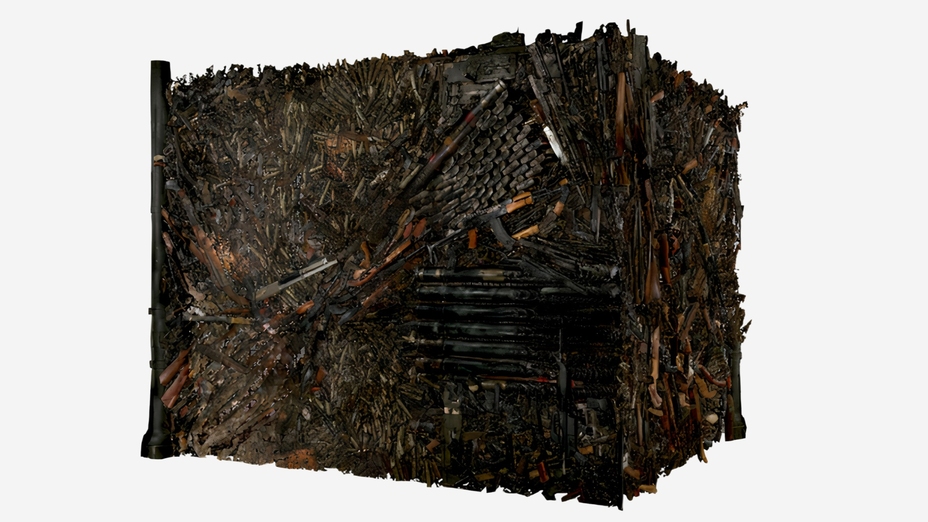
The final 3D model, a starting point for the future VR experience of the artwork. Image courtesy of My Engineering
As for the artists, their short-term plan is to feature the resulting digital twin on a new website so that users are able to rotate and explore the model and even go inside. They’re currently in discussions with museums about permanent placement, being open to other art and peace education institutions as well. While the installation is looking for a permanent home, its creators are fascinated with the long-term vision of how to spread the message of non-violence now that their work has become much more accessible to people around the world.
“A virtual exhibit would make this piece so much more accessible. Shipping the physical sculpture is a huge undertaking. It’s a three-part installation that weighs five tons, fills a jumbo container, and takes five days to set up and three to take down,” explained the artist. “Even though it was designed for touring – and has toured globally – it’s still a massive production.”
Now that she is familiar with 3D technology, Sandra Bromley is confident this is just the beginning. “I’m definitely planning to rely on 3D scanning again, especially for larger works. For sculptors, this technology is wonderful. We’ve always struggled to convey the three-dimensionality and the experience of walking around a piece. Even video doesn’t quite capture it. So I see 3D scanning as a powerful new tool for sharing my work,” she said.
To date, over 150,000 visitor contributions have been recorded, and The Gun Sculpture has inspired artists across music, visual art, and poetry. Bromley and Kendall have mentored marginalized groups, helping launch the iHuman Society, an arts-based program for youth at risk. What began as a community-powered project now has the potential to involve communities globally. Digitizing their work gives artists, museum curators, art educators, and activists enormous freedom: with no logistical constraints, they can continue their efforts anywhere in the world, reaching new audiences, expanding creative possibilities, or – just as The Gun Sculpture has done for 25 years – amplifying the voices of those silenced by violence.
Scanners behind the story
Try out the world's leading handheld 3D scanners.


